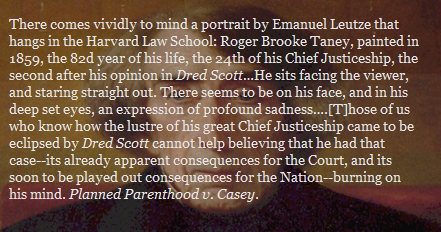Of the law and the practice of law studentry-- By MattBurke - 02 Mar 20151. In which the law and law studentry are discussedFirst, in the casebooks, that is first-in-time: The law student finds the law first-in-time in the casebooks in the bleary hours of the night. Or, since the law student prefers the ritual of falling asleep with his wife to that of reading late into the night, he finds the law first-in-time in casebooks in the bleary hours of the morning. He learns, in a red book about Civil Procedure, that casebooks do not contain law, they contain “evidence of the law.” Swift v. Tyson. Second, the law student, for a class called “ConLaw,” reads a case about abortion. In a dissent, the law student reads: Conceive, from “com-,” intensive prefix, and “capere,” "to take.” The mother who conceives is taken with child. The fetal child is the actor that takes. We rule that the ability to take, that is, to have a discernible effect in the world impossible but-for the presence of the actor, constitutes life. Life is not synonymous with citizenship. The word “citizen” means a person of the United States. The question before us is, whether the class of lives described by petitioners are constituent members of this sovereignty. We think they are not. On the contrary, they are a class of potential citizens subordinate to those beings who have entered into the polity of the United States. Although lives, therefore, they are a class of lives worthy of protection only as potential citizens.Third, the law student visits an old friend, who, regarding the student’s newfound studentry, asks: “Have you learned meaning of justice yet?” They laugh. Next, the friend asks: “Then what have you learned?” The student tells his friend about a sad old judge whose sadness became a symbol to some—a symbol for meanings both that the judge foresaw and those for the judge unforeseeable. He tells his friend about a portrait. The friend interrupts. “Like Goya,” the friend says. The friend explains—a Spaniard artist who refused to flatter his patrons, painting instead their ugliness, but so painting so deftly that the aristocracy patronized him all the same. “Yes,” says the law student. “The law can be in that regard very much like Goya.” 2. In which the role of the law and law studentry in the law student's past is unearthedFirst, old memories visit the law student. With his mother at her office, he’s bored. A man offers to shake his hand. They shake. After, the man gives the law student, then only a future law student, a piece of candy. The student’s mother explains: “He’s a partner.” This is the law student’s earliest memory of that word. When the future law student hears the word again—this time in its general usage—he experiences the dissonance common to learning children: “Partner” means “man with authority and a distant affect.” How can it also mean “companion” and “friend”? Second, before the law student began practicing law studentry, he was a teacher. He taught high school history. His curriculum contained a lesson about a case, Brown v. Board, which he later read for “ConLaw.” After explaining to his students things they already knew, he would ask them a question whose answer was already known. He would ask: “Why, at this school, are the only white people teachers?” Third, the student recalls a trial, the boy who shot up the student’s own high school. The student remembers his parents’ divorce proceedings and his great-grandmother’s will—the two silver bars devised to the student’s mother when the student was four years old. Those, he thinks, are not the law. They are alternating weekends, silver bars, and an incarcerated boy, now an incarcerated man.3. In which the path of the law is found to lead past law studentryFirst, just after Lincoln delivered the Gettysburg Address, dedicating a cemetery for some who died in Dread Scott’s “consequences for the Nation,” he remarked to a friend: “That speech won’t scour,” as a plow baked in Illinois mud won’t scour. Today, Lincoln is in a vault buried 10 feet into the Illinois mud. But his words aren't buried. I know—I had to memorize them when I was in fourth grade, as, I think, do many fourth graders. Second, when I visited my old friend, he confessed to me, after his joke about justice, a legal problem—one he'd lived with for some time. I thought to my casebooks, trying to recall a similar problem and its solution, intuiting a solution, recalling evidence of it, but the solution itself evaded me. I told him: "I'd like to help make it go away." And he replied: "Thanks." Third, I imagine the pile of words, words about the law and words not, words that help, words that harm, words that scour and those that don't—words I'll write before I meet my mud. I hope some of them are worthwhile. |
|

